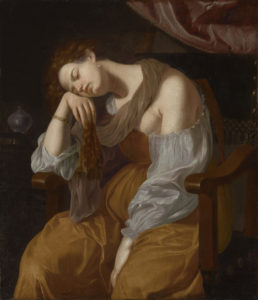The Kimbell Museum in Fort Worth, Texas, has just acquired a painting by the seventeenth-century Italian artist Artemisia Gentileschi. But the museum may make some waves with a bold claim.
Even though the Kimball Museum’s collection is relatively small compared to other major American museums, the contents are undoubtedly impressive. It is often considered one of the best art collections in the American Southwest, boasting such highlights as Caravaggio’s Cardsharps and Caillebotte’s On the Pont de l’Europe. The Gentileschi acquisition is the painting Penitent Mary Magdalene, which the museum unveiled last week on September 5th. The Penitent Magdalene was a popular subject among Renaissance and Baroque artists. She closes her eyes in contemplation, making Artemisia’s take on the subject rather different from other masters. Most paintings and sculptures of the Penitent Magdalene show her at the moment of conversion. Her eyes are often widened with awe as a light shines on her. This is apparent in paintings by Titian, El Greco, and even Artemisia’s father, Orazio Gentileschi. Keith Christiansen suggests that the pose of Artemisia’s Magdalene, her head lolling off to the side, is reminiscent of depictions of the crucifixion, lamentation, and entombment of Christ, with the surrounding figures bowing their heads with grief. Artemisia further distinguishes her Magdalene from others by refraining from showing nudity. These other Penitent Magdalene paintings all show the saint bare-breasted to indicate her previous life of sin. But Artemisia does not do that. Artemisia shows the saint with pearl earrings and a gold bracelet, representing a past life of sin by decorating her with luxurious trinkets, serving as remnants of vanity. This makes Artemisia’s version more like Caravaggio’s realistic Magdalene. The subject is also consistent with Artemisia’s penchant for strong or heroic female figures of history, mythology, and the Bible, including Lucretia, Judith, and Cleopatra.
The Kimbell Museum, however, is going against the wider academic consensus. Art historians generally agree that Gentileschi’s original Penitent Mary Magdalene hangs at Seville Cathedral’s treasury. But the Kimbell seems to assert that the Seville painting is a later copy. According to the museum’s press release, the painting was “famous and was widely copied. Yet despite its fame, the original painting subsequently disappeared. Notable copies include canvases today in Seville Cathedral and the Museo Soumaya in Mexico City.” It implies that the Seville painting is the creation of a student or a young artist making a copy or a study of a great masterwork. Art historian Mary Garrard writes that the Seville painting is “unquestionably by Artemisia’s hand.” Garrard claims the Kimbell painting is also by Artemisia herself, but it is “a replica of [the Seville painting’s] design”. Other sources, like the Saint Louis Art Museum’s 2002 Gentileschi exhibition, claim that both the Seville and Kimbell versions are Artemisia’s copies of the lost original.
The most striking difference between the Kimbell and Seville versions is the veil draped over the saint’s shoulder. In the Seville painting, the cloth is wider and covers more skin. Some speculate that this was added later to appease the Church. The absence of this addition in the Kimbell version has led art historians to theorize that the Kimbell version was painted directly from the Seville version before the extra drapery was added.
The original painting, likely the Seville version, was created around 1625 and purchased by the Duke of Alcalá, who later served as the Spanish viceroy of Naples. Some conclude that the Seville painting is the original work commissioned by the Duke. However, art historians Jonathan Brown and Richard Kagan note that the Penitent Magdalene was not listed in the Duke of Alcalá’s inventory when he transferred his collection from Naples to Seville. Therefore, the version in Seville today may be another version Artemisia made. Garrard uses several art collection inventories to deduce that Artemisia may have sold a copy to the legal scholar Ettore Capecelatro, whose estate later sold it to the banker Davide Imperiale. From there, the painting went to Imperiale’s home city of Genoa. There, the trail ends, but Garrard suggests that it’s likely that this second version is the same painting that turned up at the Tajan auction house in Paris in 2001 and now hangs at the Kimbell Museum in Texas. This, however, does not mean the Kimbell version is the original. Several scholars note that the Kimbell version seems a little more roughly done. Garrard notes that some aspects seem to have been done “in a slightly more generalized, somewhat stylized, manner.” Furthermore, the hand brought up to the face is “painted far more meticulously” in the Seville painting. The Seville version seems more like the kind of painting that would be presented as a commission from a prominent patron.
The Kimbell Museum’s director, Eric Lee, described the painting as “newly rediscovered”. I suppose there’s a bit of truth to the statement. When it came up in Paris in 2001, Tajan attributed the painting to Artemisia’s studio. So, assigning the work a full attribution to Artemisia and claiming it’s the original painting will surely provoke some interesting debates within the realm of Old Masters scholarship.

